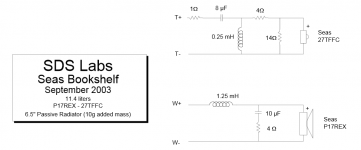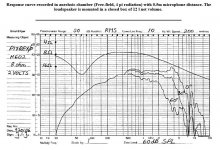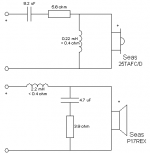If you're very nice to Dissi, he might be able to knock something up for a 3.3uF/0.47mH tweeter filter and incorporate a 1.8mH coil. Probably be more accurate than my guesses. 😱
The ancient Audiomaster MLS4 used a 6" bextrene unit with a complex midrange notch, which incidentally increases the bafflestep correction. You could lose the 0.33uF KEF Acoustic Butterworth element since I just don't think it sounded good.
I had a very rough stab at deconstructing it, though I think I overdid the bass coil values. It is rather in the KEF/BBC tradition and is a Robin Marshall design IIRC:
The ancient Audiomaster MLS4 used a 6" bextrene unit with a complex midrange notch, which incidentally increases the bafflestep correction. You could lose the 0.33uF KEF Acoustic Butterworth element since I just don't think it sounded good.
An externally hosted image should be here but it was not working when we last tested it.
I had a very rough stab at deconstructing it, though I think I overdid the bass coil values. It is rather in the KEF/BBC tradition and is a Robin Marshall design IIRC:
An externally hosted image should be here but it was not working when we last tested it.
OK, here's my guess where you want to be. 😱
This uses your existing components. I have adapted the SDS Labs bass filter, and tweaked your treble filter and added an attenuator which you'll have to adjust yourself for tonal balance, but keep the overall attenuator plus (6 ohm DCR?) tweeter load around 8-10 ohms for a good impedance. It's about 2.8kHz crossover.
You can, of course, just try your existing second order tweeter with a regular attenuator. Adding bafflestep to the bass takes its level down a tidge, so you'll need to adjust levels. No idea how it'll sound, and I can't attempt a midrange notch on my sort of rough and ready modelling, but it sure can't be worse! 😀
This uses your existing components. I have adapted the SDS Labs bass filter, and tweaked your treble filter and added an attenuator which you'll have to adjust yourself for tonal balance, but keep the overall attenuator plus (6 ohm DCR?) tweeter load around 8-10 ohms for a good impedance. It's about 2.8kHz crossover.
You can, of course, just try your existing second order tweeter with a regular attenuator. Adding bafflestep to the bass takes its level down a tidge, so you'll need to adjust levels. No idea how it'll sound, and I can't attempt a midrange notch on my sort of rough and ready modelling, but it sure can't be worse! 😀
Attachments
OK, here's my guess where you want to be. 😱
This uses your existing components. I have adapted the SDS Labs bass filter, and tweaked your treble filter and added an attenuator which you'll have to adjust yourself for tonal balance, but keep the overall attenuator plus (6 ohm DCR?) tweeter load around 8-10 ohms for a good impedance. It's about 2.8kHz crossover.
You can, of course, just try your existing second order tweeter with a regular attenuator. Adding bafflestep to the bass takes its level down a tidge, so you'll need to adjust levels. No idea how it'll sound, and I can't attempt a midrange notch on my sort of rough and ready modelling, but it sure can't be worse! 😀
Oh! It's really appreciated! I can't thank you enough. 😉🙂
This is incorrect.
A series network has the filter components in series and the network is parallel to the driver.
A parallel network has the filter components in parallel and are in series with the driver.
Hi,
The type of the network does not define its function
relative to the the driver and you are incorrect.
A series notch is a parallel network in series, e.g. full range EQ.
A parallel notch is a series network in parallel, e.g. tweeter impedance.
rgds, sreten.
We started by saying midrange on small drivers is tricky to get flat, though sreten seems to think it is easy.
But this lively reed cone SEAS ER18RNX also has a 5kHz peak that might be problematic:
H1456-08 ER18RNX
Hi,
Its not difficult with adequate modelling of baffle step with
decent drivers to get the midrange right below the x/o point.
A trick you could use with that Seas driver is a small capacitor
(+ R?) across the BSC inductor tuned to the 4.5KHz peak,

But here in this design Zaph|Audio - ZA-SR71
it is basically ignored with the 1.75KHz x/o point, still there though :

But in the big scheme of things, not much of an issue :
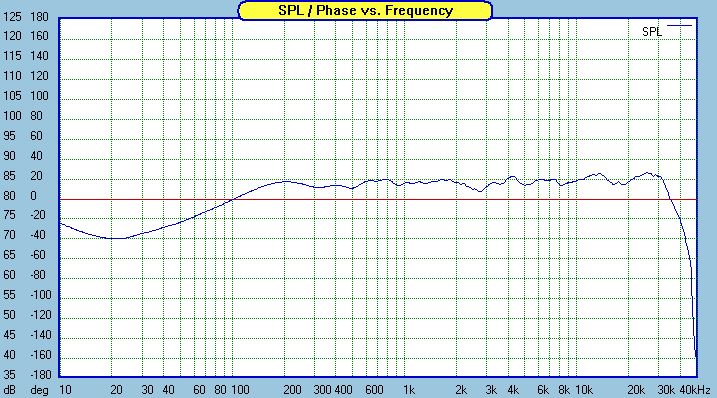
rgds, sreten.
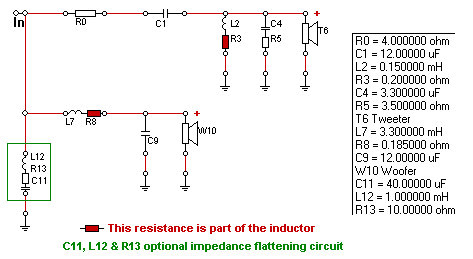
Note that BSC is done without parallel resistors on the
BSC coil and without a zobel on the bassmidrange,
and the BSC coil smoothly morphs into part of the 2nd
order electrical low pass, for 4th order L/R acoustic,
with a bit of assymetry to phase align drivers at x/o.
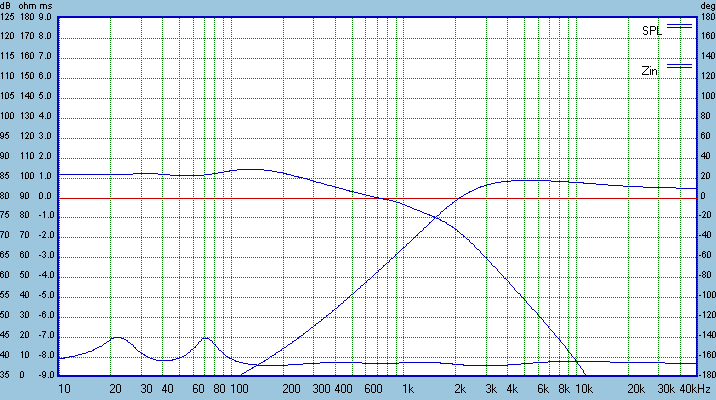
http://audio.claub.net/Simple Loudspeaker Design ver2.pdf
http://www.rjbaudio.com/Audiofiles/FRDtools.html
http://web.archive.org/web/20090902124715/http://geocities.com/woove99/Spkrbldg/DesigningXO.htm
Last edited:
This brings us back to where we started really, sreten. You either use notches, or a huge bafflestep coil and maybe push the crossover lower too.
The Reed Cone SEAS ER18RNX is familiar territory. Zaph has used a big 3.3mH coil, and around 1.5kHz crossover and no notches here. Another approach is a 5kHz LCR notch with about 2.5mH coil. Then there is Troels' midrange notch with a smaller 1.2mH bass coil too.
Gornir had a look at Zaph's design: www.audioexcite.com ZaphAudio ZA-SR71 Review!
It only works because of the good SEAS 27TDFC which can do 1.5kHz crossover.
I had a look at a 4kHz RC tank notch across the BSC coil on the SEAS polycone. It pushed the crossover down to around 2kHz, which I think would be problematic for prescott's tweeter. But maybe Dissi can sim something more accurately than me here.
I still think this is a very hard problem. 🙂
The Reed Cone SEAS ER18RNX is familiar territory. Zaph has used a big 3.3mH coil, and around 1.5kHz crossover and no notches here. Another approach is a 5kHz LCR notch with about 2.5mH coil. Then there is Troels' midrange notch with a smaller 1.2mH bass coil too.
Gornir had a look at Zaph's design: www.audioexcite.com ZaphAudio ZA-SR71 Review!
It only works because of the good SEAS 27TDFC which can do 1.5kHz crossover.
I had a look at a 4kHz RC tank notch across the BSC coil on the SEAS polycone. It pushed the crossover down to around 2kHz, which I think would be problematic for prescott's tweeter. But maybe Dissi can sim something more accurately than me here.
I still think this is a very hard problem. 🙂
Series and parallel are relative to the driver.
Ok, I see where the confusion is. Just a typo I'm assuming?The type of the network does not define its function
relative to the the driver <snip>.
Just like I said.A series notch is a parallel network in series
Again. So please explain the incorrect part.A parallel notch is a series network in parallel
I would rather call it:
- parallel RLC in series with the driver
- series RLC in parallel with the driver
I completely misread what sreten put down and then quoted it. No wonder there is confusion. Let me try this again.
Series notch:
https://www.google.ca/search?q=seri...5.7140j0j7&sourceid=chrome&es_sm=119&ie=UTF-8
Parallel notch:
https://www.google.ca/search?q=para...alculator%2FParallelNotch%2FHelp.aspx;170;200
Those two are backward. A series notch is a series network shunting the driver. A parallel notch is a parallel network in series with the driver.A series notch is a parallel network in series, e.g. full range EQ.
A parallel notch is a series network in parallel, e.g. tweeter impedance.
Series notch:
https://www.google.ca/search?q=seri...5.7140j0j7&sourceid=chrome&es_sm=119&ie=UTF-8
Parallel notch:
https://www.google.ca/search?q=para...alculator%2FParallelNotch%2FHelp.aspx;170;200
I would rather call it:
- parallel RLC in series with the driver
- series RLC in parallel with the driver
Yes, it couldn't be clearer than that! 🙂
I use the series RLC in parallel with the driver a lot where I need to tailor the frequency response to achieve the desired topology roll off.
/Göran
Cal,
you relate to how elements are wired among themselves,
Sreten means how this filter relates to driver. Your series
is Sreten's parallel.
you relate to how elements are wired among themselves,
Sreten means how this filter relates to driver. Your series
is Sreten's parallel.
I use the series RLC in parallel with the driver a lot
where I need to tailor the frequency response to achieve
the desired topology roll off.
Me too.

Cal,
you relate to how elements are wired among themselves,
Sreten means how this filter relates to driver. Your series
is Sreten's parallel.
A picture says more than thousand words! 🙂
In my experience the "Parallel RLC in series with the driver" should be avoided if possible because it has a negative sonic impact.
Regards
/Göran
Attachments
Hi,
Tweeter impedance compensation is a series LCR in parallel
with the driver. Its a parallel notch, not a series notch.
Parallel notches are series LCR, and series notches parallel LCR.
rgds, sreten.
No, tweeter impedance compensation is a series RC network in parallel with the driver. It is not a notch but a zobel.
I saw Cas has already addressed the issue of terminology. BTW, in principle, either kind of notch is produced by just an L and a C. R is for Q setting but can in some instances be absent.
I completely misread what sreten put down and then quoted it. No wonder there is confusion. Let me try this again.
Those two are backward. A series notch is a series network shunting the driver. A parallel notch is a parallel network in series with the driver.
Hi,
What is backward and what is forward seems to be to
some a matter of opinion, who seem to be able to
freely interchange the meaning of some terms.
A series notch on a driver is a network in series with it.
A parallel notch on a driver is a network in parallel with it.
The type of networks are opposite to the type of notch.
A series notch can only increase total seen impedance.
A parallel notch can only decrease total seen impedance.
The function of the notch is defined relative to the driver.
If you disagree, don't simply say its the opposite
because you (and plently of others) think it is.
Talk some real sense in defining terms.
rgds, sreten.
Pas de tout, vacuphile, c'est aussi necessaire a egalise le Fs Resonance avec un LCR de series, Le RC Zobel egalise l'inductance de tweeter...😀No, tweeter impedance compensation is a series RC network in parallel with the driver. It is not a notch but a zobel...snip.
Which is all very dull and probably also bad French. But none of you flipping geniuses are helping prescott with his blooming SEAS bass unit. 😡
Attachments
Pas de tout, vacuphile, c'est aussi necessaire a egalise le Fs Resonance avec un LCR de series, Le RC Zobel egalise l'inductance de tweeter...😀
Which is all very dull and probably also bad French. But none of you flipping geniuses are helping prescott with his blooming SEAS bass unit. 😡
Tu as tort! Sreten was talking about impedance correction. The fact that you may also need to dampen a peak is true but is separate from impedance correction.
But none of you flipping geniuses are helping prescott with his blooming SEAS bass unit. 😡
Yes, true but how could you help him without measurements?
It's like instructing him via a cell phone to turn right or left when he's driving on the wrong side of the highway..... 😉
Regards
/Göran
I've just hit paydirt! 😀
There was a 12L SEAS kit called the Embla a few years back. It's a reflex design using the SEAS P17REX (which is incredibly similar to the P17REX/P) and the 25TAFC/D.
Crossover below. My guess wasn't bad! 😎
A 2.2mH looks better though. Dealing with the midrange shout on Barbie's voice, an all that. Still not sure if presscot's tweeter is up to it though. Looks a low crossover to me.
There was a 12L SEAS kit called the Embla a few years back. It's a reflex design using the SEAS P17REX (which is incredibly similar to the P17REX/P) and the 25TAFC/D.
Crossover below. My guess wasn't bad! 😎
A 2.2mH looks better though. Dealing with the midrange shout on Barbie's voice, an all that. Still not sure if presscot's tweeter is up to it though. Looks a low crossover to me.
Attachments
Last edited:
- Status
- Not open for further replies.
- Home
- Loudspeakers
- Multi-Way
- Notch filter for midrange ???


